
Introduction to Geothermal Energy
1. Definition and Basic Principles of Geothermal Energy:
Geothermal energy originates from the heat within the Earth’s sub-surface. It’s a renewable energy form that natural processes like radioactive decay continuously generate. The Greek words “geo” (earth) and “therme” (heat) combine to form the term “geothermal”, effectively translating to “Earth’s heat.”
We can harness and use this heat in various ways. The Earth’s temperature at shallow depths remains fairly constant throughout the year, which can be utilized to heat and cool buildings with geothermal heat pumps. At greater depths, temperatures can soar to hundreds of degrees Celsius. These conditions create geothermal reservoirs, from which we can extract steam and hot water to power electricity-generating turbines.
2. History of Geothermal Energy Use:
People have been using geothermal energy since ancient times, for bathing, cooking, and heating, with hot springs serving as the source. Historians believe that the oldest known spa, a stone pool fed by a hot spring, was built on Lisan Mountain, China, in the 3rd century BC.
The early 19th century near Pisa, Italy, marked the first industrial use of geothermal energy. Here, people used steam from natural vents to extract boric acid from volcanic mud.
In 1904, the first test of a geothermal power generator took place in Larderello, Italy. This generator successfully lit four light bulbs. By the 1930s, commercial production of geothermal electricity was well underway in Italy.
In the United States, geothermal energy was first used to produce electricity in 1960, at The Geysers field in California. The site is still one of the world’s largest geothermal fields.
The development and use of geothermal energy have been growing since then. With advances in technology, it’s now possible to produce geothermal energy even in areas without hot springs or other visible signs of geothermal activity, expanding its potential as a significant source of clean, renewable energy.
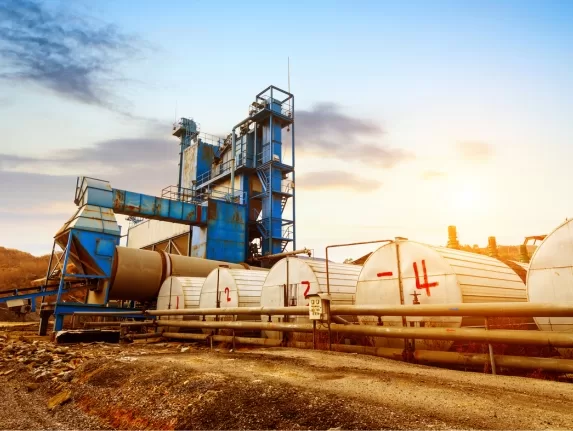
Types of Geothermal Energy
1. Direct Use and District Heating Systems:
Direct use of geothermal energy involves harnessing the heat from hot water reservoirs near the earth’s surface and using it directly for heating buildings, growing plants in greenhouses, de-icing roads, or for industrial processes that require heat. The temperature of these resources typically ranges from 20°C to 150°C.
District heating systems use networks of insulated pipes to distribute hot water or steam from a geothermal well to provide space heating and hot water to homes and businesses in a community. It’s particularly effective in areas with a high population density and is used widely in countries like Iceland and Denmark.
2. Electricity Generation in Power Plants:
Geothermal power plants produce electricity by using heat from the Earth’s core to heat water or another working fluid, which then turns a turbine connected to a generator. There are three types of geothermal power plants:
- Dry steam plants use steam from a geothermal reservoir to turn generator turbines. The first geothermal power plant was a dry steam design.
- Flash steam plants pull deep, high-pressure hot water into lower-pressure tanks and use the resulting flashed steam to drive turbines.
- Binary cycle plants use the heat from hot water to boil a working fluid, usually an organic compound with a low boiling point. The vapor from the working fluid then drives the turbines.
3. Geothermal Heat Pumps:
Geothermal heat pumps, also known as ground-source heat pumps, leverage the relatively stable temperature of the ground or bodies of water to provide heating in the winter and cooling in the summer. Pipes are buried in the ground and filled with a fluid. In the winter, the fluid absorbs heat from the earth and brings it to the surface to warm the building. In the summer, the system operates in reverse, removing heat from the building and depositing it into the ground.
Each of these methods has its advantages and disadvantages, but all provide cleaner and more sustainable energy solutions than many traditional forms of energy.

Geothermal Energy Resources
1. Geothermal Reservoirs:
Geothermal reservoirs are regions located a few kilometers beneath the Earth’s surface where we find abundant hot water and steam. They are created when groundwater seeps down into the Earth and is heated by magma. Over time, this heated water can accumulate in permeable rock or fractures, creating a geothermal reservoir. These reservoirs are the primary targets for geothermal drilling and development for electricity generation.
2. Hot Springs and Geysers:
Natural surface manifestations of geothermal energy include hot springs and geysers. Hot groundwater surfaces at specific locations known as hot springs. For thousands of years, humans have bathed in these hot springs, and they remain a popular recreational activity today.
Just like hot springs, magma heats underground water to create geysers. The distinctive feature of geysers is the intermittent discharges of turbulently ejected water, often accompanied by steam.
While people don’t commonly use geysers and hot springs for energy production, they often indicate a strong geothermal resource. This resource could be suitable for power production or direct use applications.
3. Tectonic Plate Boundaries and Hot Spots:
Geothermal resources are often found along tectonic plate boundaries, where Earth’s crust is most active with volcanic activity and earthquakes. These include the edges of the Pacific Plate, also known as the “Ring of Fire,” and the boundary between the North American Plate and the Eurasian Plate, which runs through Iceland.
Hot spots are places within tectonic plates where plumes of magma rise from deep within the Earth to create volcanic activity. They can also serve as sources of geothermal energy. A well-known example is the Yellowstone Hotspot in the United States.
These geothermal resources provide significant renewable energy potential, offering a reliable, clean, and virtually inexhaustible power source. Harnessing this energy effectively and responsibly, however, presents several technical and environmental challenges.
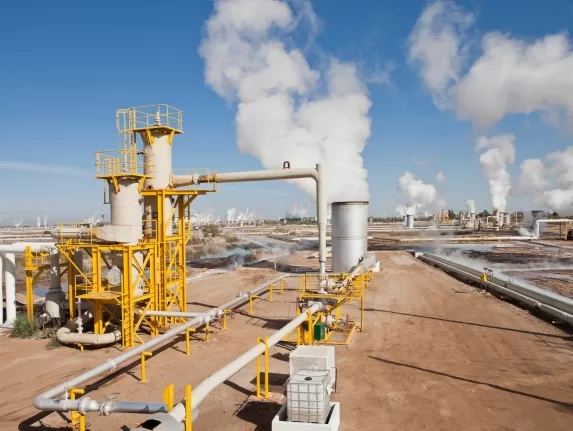
Geothermal Energy Extraction and Conversion
1. Drilling and Extraction Methods:
Drilling is the first step in the extraction of geothermal energy, similar to drilling for oil or natural gas. However, geothermal drilling often involves drilling several kilometers into the Earth’s crust to reach high-temperature reservoirs.
There are two primary methods of extraction:
- Dry Steam Power Plants: These plants draw from underground resources of steam. The steam is piped directly from underground wells to the power plant, where it drives a turbine which activates a generator.
- Flash Steam Power Plants: These are the most common. They use geothermal reservoirs of water with temperatures greater than 180°C. The high-pressure water is depressurized or “flashed” into steam which then drives the turbines.
2. Heat Transfer and Conversion into Electricity:
Once the hot fluids have been brought to the surface, they can be used to generate electricity. Here’s a simplified explanation of the process:
- Wells bring steam or high-temperature water to the surface which is then directed towards a turbine. As the steam or water turns the turbine, it converts the thermal energy into mechanical energy.
- The turbine connects to a generator, so when the turbine spins, it causes the generator to spin as well. The generator then converts this mechanical energy into electrical energy.
- The electricity grid transmits this electrical energy as high-voltage power to homes, businesses, and industries.
In binary power plants, the geothermal water heats a second fluid in a heat exchanger that vaporizes and turns the turbine. This method allows for geothermal electricity production at lower temperatures and is becoming more common as technology advances.
One of the key advantages of geothermal power plants is their ability to provide base load power, i.e., they can operate continuously, unlike wind and solar power plants that depend on weather conditions. However, the challenge lies in locating geothermal resources and the costs associated with drilling and building a power plant.

Efficiency and Sustainability of Geothermal Energy
1. Comparative Efficiency with Other Energy Sources:
When compared to fossil fuels, geothermal energy is significantly more efficient. Geothermal power plants use a renewable heat source from the Earth’s crust that is always available, weather-independent, and does not require any fuel to be burned. The efficiency of a geothermal power plant ranges from 10-20% based on the second law of thermodynamics, but because the fuel (heat) is free, this efficiency is cost-effective.
Furthermore, geothermal power plants have high capacity factors, which is the ratio of the actual energy produced in a given period to the hypothetical maximum possible (i.e., running full time at rated power). While solar and wind power have capacity factors around 20-40%, geothermal power plants can have capacity factors above 90%, meaning they can provide consistent, base load power.
2. Renewable Aspect of Geothermal Energy:
Geothermal energy is considered renewable because it’s derived from the natural heat of the Earth, which is replenished continuously by the decay of naturally radioactive isotopes including potassium, thorium, and uranium. In most cases, the rate of heat extraction can be balanced with a sustainable rate of heat recharge.
Also, unlike fossil fuels, geothermal energy production doesn’t involve combustion, so it results in low emissions of greenhouse gases. Direct emissions from a geothermal power plant are just a small fraction of the emissions from a natural gas power plant and are virtually nothing compared to a coal power plant.
With proper management, the geothermal source can produce power sustainably for an indefinite period. Certain projects around the world have been producing electricity for more than 100 years. Therefore, while there are environmental and logistical considerations to account for, geothermal energy can be a highly efficient and sustainable power source.
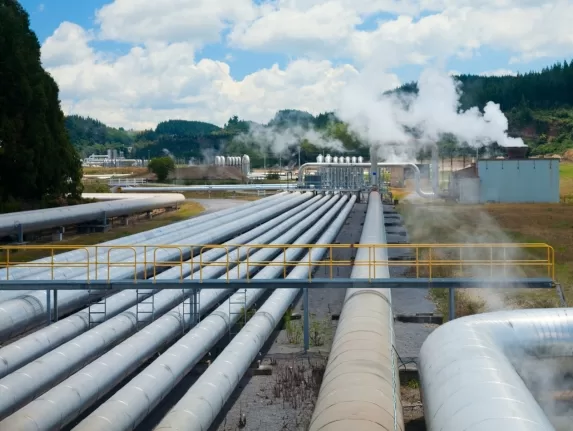
Advantages and Disadvantages of Geothermal Energy
1. Advantages of Geothermal Energy:
- Renewable and Sustainable: As previously mentioned, geothermal energy is both renewable and sustainable. It’s a non-exhaustible energy source that can provide heat and electricity for many years without depleting the Earth’s resources.
- Environmentally Friendly: Geothermal energy is a clean source of energy. It emits 80 to 90 percent fewer greenhouse gases compared to fossil fuel energy sources.
- High Capacity Factor: Geothermal plants have an excellent capacity factor. They can produce energy 24/7, regardless of weather conditions, unlike solar and wind energy.
- Low Maintenance: Once established, geothermal power plants require relatively low maintenance, which can reduce the operating costs.
2. Environmental Impact of Geothermal Energy:
While geothermal energy has several advantages, it does come with some environmental concerns:
- Water Usage: Geothermal plants use water for cooling, which can be a problem in areas with water scarcity.
- Surface Instability: The process of drilling and extracting geothermal energy can sometimes lead to surface instability, causing minor earthquakes or subsidence.
- Emissions: While much cleaner than fossil fuel power plants, geothermal plants do emit some greenhouse gases trapped beneath the Earth’s surface, including carbon dioxide and sulfur dioxide.
3. Cost and Economic Factors:
Geothermal power plants can be expensive to set up but have low operation and maintenance costs. The drilling process to reach hot water or steam reservoirs is costly and risky, as the presence of geothermal resources is not always guaranteed.
However, once the plant is operational, the costs are usually low since the energy source – heat from the Earth – is free, and the plants generally require less maintenance than other power plants.
4. Limitations of Geothermal Energy:
- Geographical Limitations: Geothermal energy is location-specific. It can only be harnessed in areas where the geothermal reservoirs are close to the Earth’s surface. While technology for low-temperature resources is improving, high-temperature resources are the most cost-effective for power generation.
- Resource Depletion: If the water or steam from a reservoir is extracted faster than it is replenished, the reservoir can deplete, though this is usually a concern for poorly managed systems.
- Infrastructure: Geothermal plants often require significant infrastructure, including drilling rigs and power plants, which can disrupt local ecosystems.
Despite these challenges, geothermal energy remains one of the most promising sources of renewable energy due to its reliability and low emissions. With advances in technology, it may become a more integral part of the global energy mix.
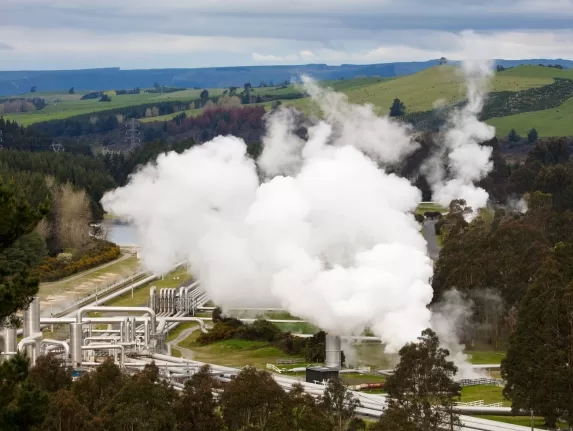
Geothermal Energy Around the World
1. Leading Countries in Geothermal Energy:
Several countries have made substantial strides in harnessing geothermal energy:
- The United States: As of my knowledge cutoff in September 2021, the United States was the world leader in geothermal energy production, with the largest installed capacity. Key areas include California (The Geysers Geothermal Field, which is the largest geothermal power complex in the world) and Nevada.
- The Philippines: The country is the second-largest producer of geothermal energy, utilizing its location along the Ring of Fire.
- Indonesia: Indonesia has significant geothermal potential and is working towards harnessing more of its geothermal resources.
- Iceland: While it has a small population, Iceland is a big player in the geothermal world. It uses geothermal energy for around 30% of its electricity and nearly 90% of its heating and hot water needs.
- Kenya: The East African country is also a significant geothermal producer, using the resource for a substantial portion of its electricity generation.
2. Geothermal Energy in Developing Nations:
For many developing nations, especially those located along tectonic plate boundaries, geothermal energy presents a significant opportunity to increase their energy independence, boost rural electrification, and reduce reliance on fossil fuels. However, the upfront costs and exploration risks can be barriers.
Countries such as Kenya and Indonesia are leading examples of developing nations that are tapping into their geothermal potential. The United Nations and World Bank also support geothermal projects in developing countries through various initiatives and funding mechanisms to help mitigate financial risks and technical challenges.
By harnessing geothermal energy, these countries can not only meet their growing energy needs but also contribute to global efforts to combat climate change by transitioning to clean, renewable energy sources. However, effective regulatory frameworks, proper planning and management, and the training of local experts are crucial for the sustainable development of geothermal resources.
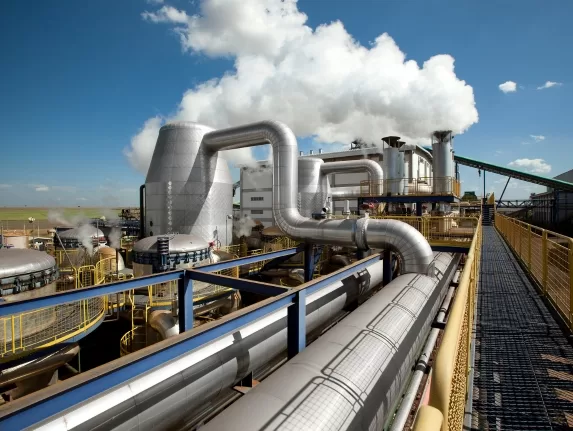
Technological Advancements in Geothermal Energy
1. Enhanced Geothermal Systems (EGS):
Enhanced Geothermal Systems are a new type of geothermal power technologies that do not require natural convective hydrothermal resources. Instead, they involve injecting water into hot rocks to create artificial geothermal reservoirs. Once the system is established, the operation is similar to natural geothermal power plants.
The benefit of EGS is that it could greatly expand the potential for geothermal energy because it’s not limited to regions with active or young volcanism. It could potentially be implemented anywhere there is accessible hot rock, potentially multiplying the energy available. However, as of my knowledge cutoff in 2021, it’s still in the early stages of development and commercialization.
2. New Drilling Technologies:
The cost of drilling and risks associated with exploring for geothermal resources are significant barriers to the expansion of geothermal power. As a result, new drilling technologies are being developed to mitigate these challenges.
Some of these technologies include:
- Deep drilling techniques borrowed from the oil and gas industry that can reach depths of 10km or more, potentially accessing extremely high-temperature resources.
- Directional drilling technologies that allow for greater control over the well’s path, enabling the exploitation of a larger volume of a reservoir.
- Hard rock drilling technologies designed to improve the rate of penetration and the lifetime of drill bits, potentially reducing costs and improving the economics of geothermal projects.
These advancements, along with improved methods for reservoir characterization and management, are making geothermal energy more efficient and accessible. This progress is essential for the continued growth and viability of geothermal energy as a significant contributor to the world’s energy mix.
By harnessing new technologies and innovations, we can better utilize the enormous amount of heat stored beneath the Earth’s surface and help to meet our energy needs in a sustainable way.
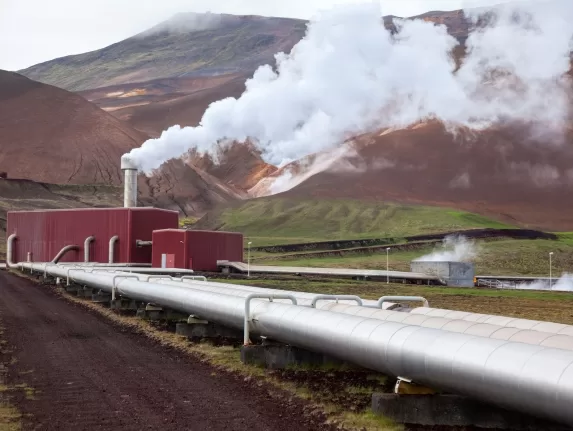
Geothermal Energy and Climate Change
1. Role of Geothermal Energy in Reducing Carbon Emissions:
Geothermal energy plays a crucial role in reducing carbon emissions. Unlike fossil fuels, which release large amounts of CO2 when burned, geothermal energy is a low-carbon source of heat and electricity. It emits around 80 to 90 percent less CO2 compared to coal and natural gas power plants. By replacing fossil fuels, geothermal energy helps to mitigate climate change by reducing the amount of greenhouse gases released into the atmosphere.
2. Contribution to Sustainable Development Goals (SDGs):
Geothermal energy can contribute to several of the United Nations’ Sustainable Development Goals:
- SDG 7 (Affordable and Clean Energy): Geothermal energy provides a reliable, renewable, and environmentally friendly source of heat and power.
- SDG 13 (Climate Action): By reducing carbon emissions, geothermal energy contributes to global efforts to combat climate change.
- SDG 9 (Industry, Innovation, and Infrastructure): The development and deployment of geothermal technologies promote sustainable industrialization and foster innovation.
- SDG 8 (Decent Work and Economic Growth): Geothermal energy projects can create jobs and stimulate economic growth, particularly in rural and isolated areas.
- SDG 6 (Clean Water and Sanitation): Some geothermal power plants are designed to co-produce clean water, thus contributing to clean water supply.
Geothermal energy, therefore, offers a promising pathway towards achieving several of the SDGs, as it is not only a sustainable solution for meeting our energy needs, but also fosters economic development and environmental protection. However, it’s important to note that the development of geothermal resources must be done responsibly to avoid potential environmental impacts, such as water use and induced seismicity.
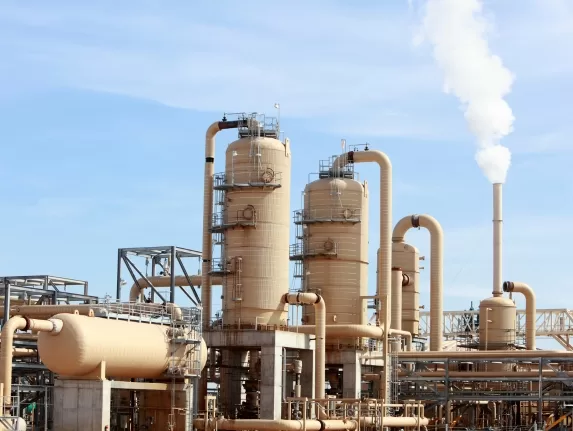
Future Prospects of Geothermal Energy
1. Potential for Increased Global Usage:
The International Energy Agency (IEA) suggests that geothermal power could potentially supply about 3.5% of global electricity production by 2050, and 3.9% of global heat demand. This is under their Sustainable Development Scenario, which envisions a major shift towards renewable energies to meet climate goals.
Geothermal energy has the potential to be utilized in a variety of ways beyond just power generation. It can also be used for heating and cooling systems, industrial processes, and even in agriculture for soil warming and crop drying.
As technology advances, the efficiency of geothermal power plants will likely improve, and new methods such as Enhanced Geothermal Systems (EGS) could significantly increase the availability of geothermal energy around the world.
2. Challenges and Solutions for Future Development:
Despite its potential, there are still several challenges that need to be overcome for geothermal energy to be widely adopted:
- High Initial Costs: The cost of exploration and drilling for geothermal resources can be quite high. However, with advances in drilling technology and better geoscientific data, these costs could be reduced in the future.
- Geographical Limitations: Currently, geothermal energy is primarily exploited in regions with high seismic activity. However, techniques like EGS could make it feasible to harness geothermal energy in a wider variety of locations.
- Environmental Concerns: Although geothermal is a clean source of energy, there can be environmental impacts, including water usage, induced seismicity, and the release of greenhouse gases. Further research and regulation are needed to mitigate these impacts.
- Technical Challenges: Enhanced Geothermal Systems and other advanced geothermal technologies are still in the early stages of development. More research and investment are needed to mature these technologies and bring them to market.
The future development of geothermal energy will depend on overcoming these challenges. With continued investment in research and development, and supportive policy frameworks, geothermal energy has the potential to play a significant role in our future energy mix and contribute to a sustainable and low-carbon future.